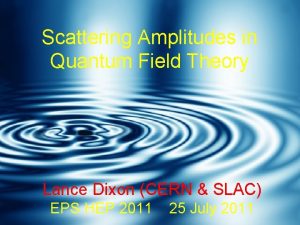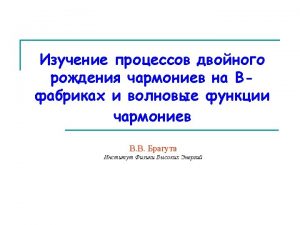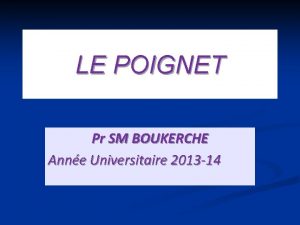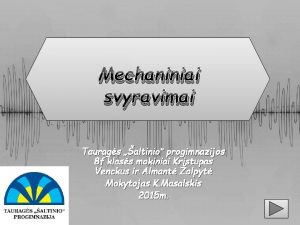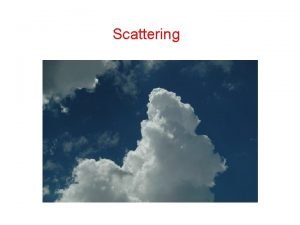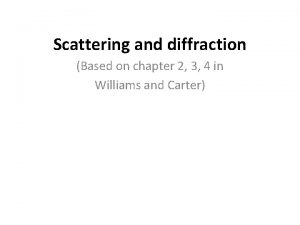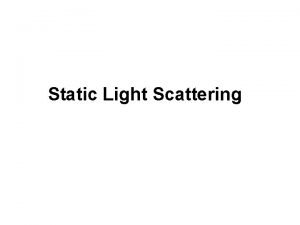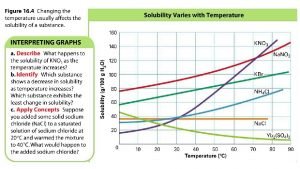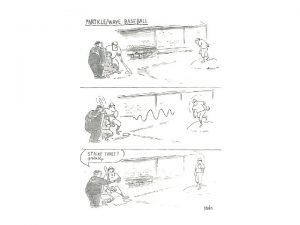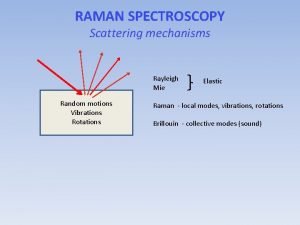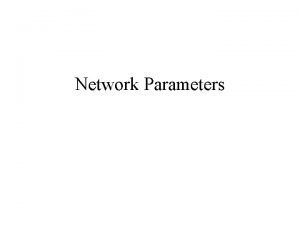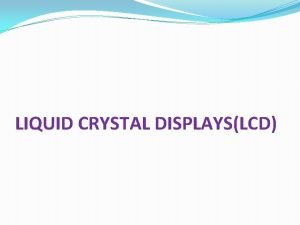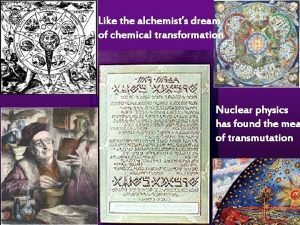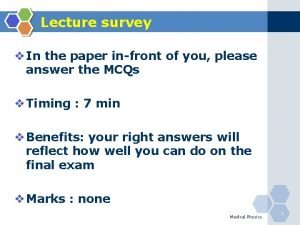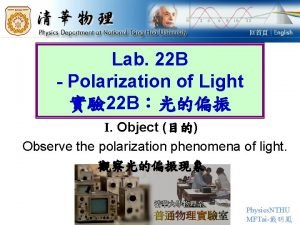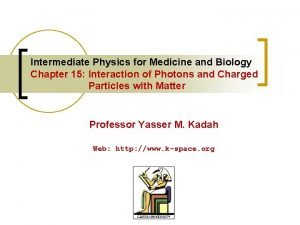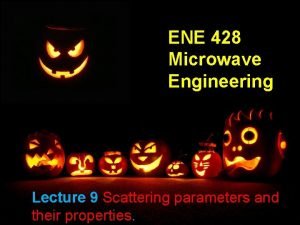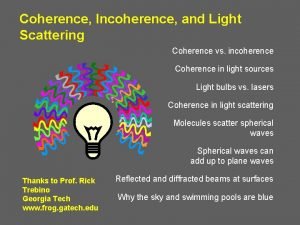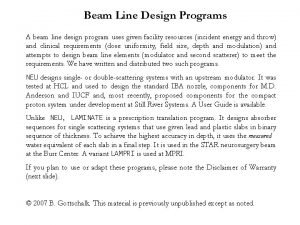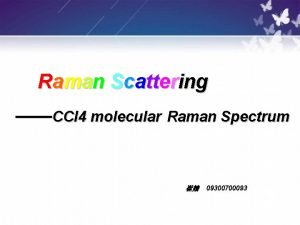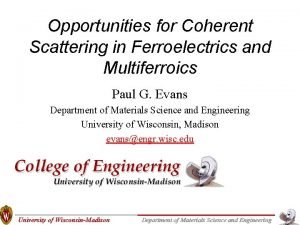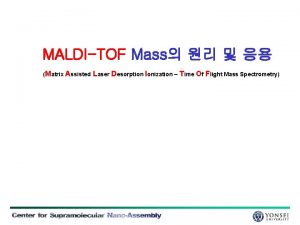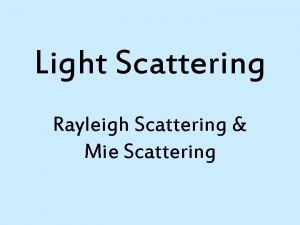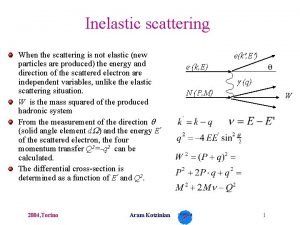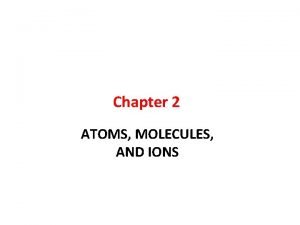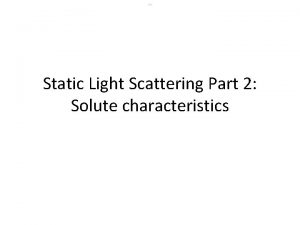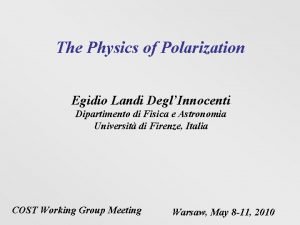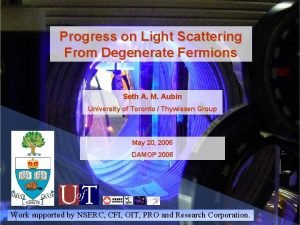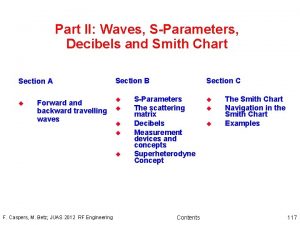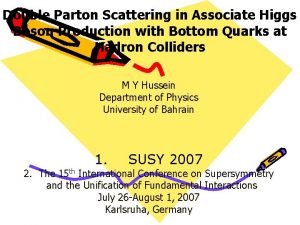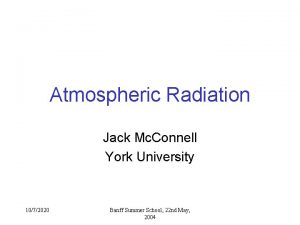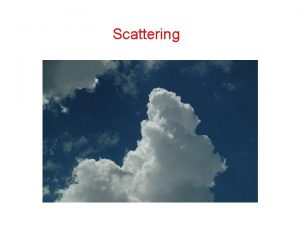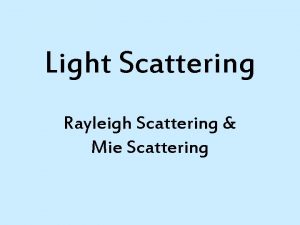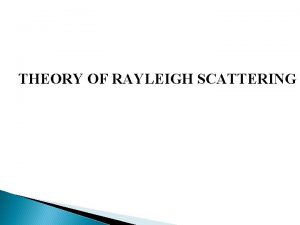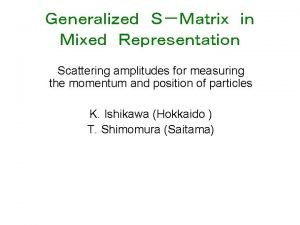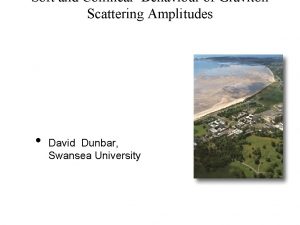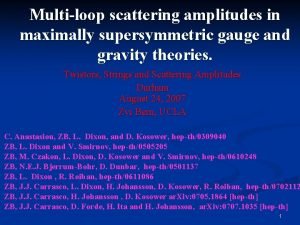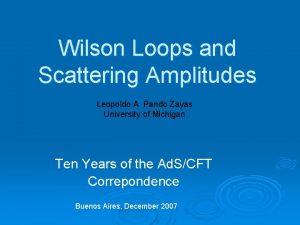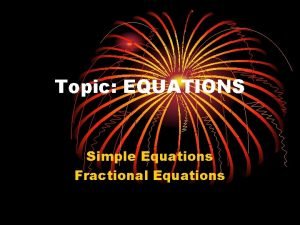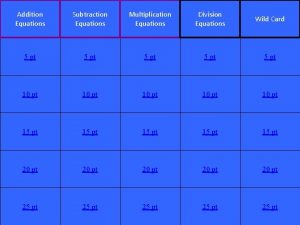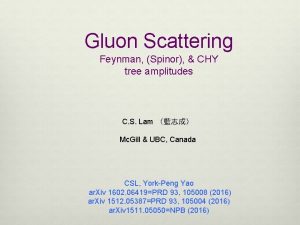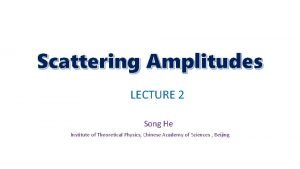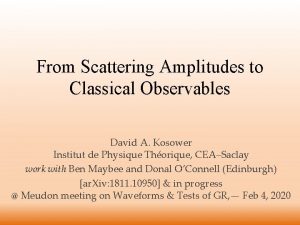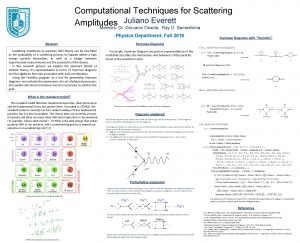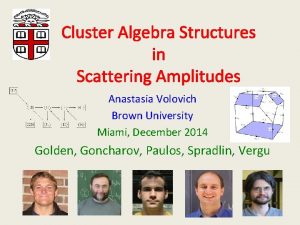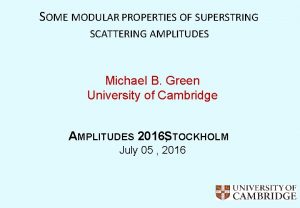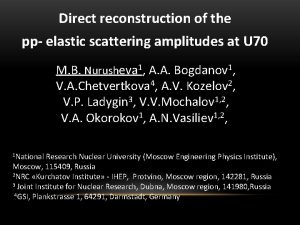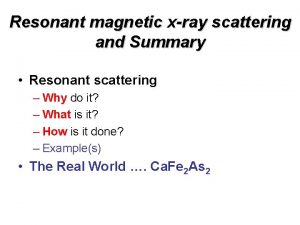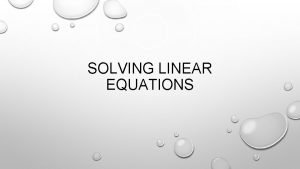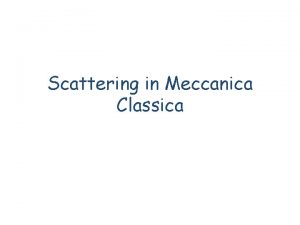Amplitudes from Scattering Equations and Qcuts Amplitudes 2017


































- Slides: 34

Amplitudes from Scattering Equations and Q-cuts Amplitudes 2017, Edinburgh N. Emil J. Bjerrum-Bohr Based on work together with: C. Baadsgaard-Jepsen, J. Bourjaily, S. Caron-Huot, P. Damgaard, B. Feng) (ar. Xiv: 1508. 03627 and 1509. 02169)

Scattering equation and new representations of amplitudes l We have recently witnessed a number of new formulations of perturbative amplitudes l A particularly intriguing new concept is the scattering equation formalism Color trace factor, very alike to cyclic trace in MHV amplitudes Algebraic solutions Pfaffian (depends on polarizations and momenta) 2

The N-point scalar amplitude 3 For the N-point scalar amplitude (s = 0) one has Here Sum over solutions are the scattering equations where Generally complicated solutions at higher points. N-roots of Polynomial equations. (can be complex) Much like standard Kobe-Nielsen gauge fixing

The N-point gluon amplitude 4 For gluons (s = 1) we have Sum over solutions Cyclic trace Polarizations and momenta

Some results 5 Some results Proof of amplitude formulas via BCFW Recursion (Dolan and Goddard) Scattering equation formalism from the view point of Ambi-twistor space. (Mason and Skinner; Adamo, Casali and Skinner; Casali and Tourkine) (See Mason’s talk) Scattering equation formalism from the view point of pure spinor formalism. (Berkovits; Gomez and Yuan) 5

Using the scattering eq. formalism l Basically currently options for evaluation: l Direct numerical solutions Numerically very hard beyond 7 pt. . Normally (real) numerical results from 6 pt up. (See also e. g. Dolan and Goddard; Søgaard and Zhang; Bosma, Søgaard and Zhang) l Using rules for evaluation of residues: scattering eq. rules for scalars, see e. g. (Cachazo, He and Yuan; Baadgaard Jepsen, NB, Bourjaily, Damgaard, Feng; Gomez) and recent extension to gluons (NB, Bourjaily, Damgaard, Feng; Cardona, Feng, Gomez and Huang)

Point of view : l CHY formalism viewed as a very explicit truncation of low(NEJB, Damgaard, Tourkine, Vanhove) energy string scattering. l Useful: no need for integrations l Advantages: Certain string considerations/symmetries can carry over… l E. g. both CHY formalism and string theory share invariance under Mobius transformations and amplitudes are built up in similar ways. l Important feature: in our approach the Koba-Nielsen factor is kept partially in derivations. .

Comparison between scattering equations and traditional string theory Scattering eq. prescription Integration in an ordered manner along the real line. Integral saturated by deltafunction and amplitude becomes localized. Poles comes from pinching regions. Solutions not necessarily on real line. 8

Integration rules for scattering eq. The rules l Have integrand H(z) with weight 2 in all variables (Mobius invariance). l The integration rule is (Baadsgaard-Jepsen, NEJBB, Bourjaily, Damgaard) If: Integrand has factors where Set of points (or compliment set of points) Starting point: find nested sets in diagram. All pairs of set have to satisfy that either they are nested (or their compliment are).

Integration rules for scattering eq. Example

Some interesting observations in the ’tree’ scattering equation formalism l Scattering Equation formalism : no specific dimension. l The CHY approach extendable to many different field theories (for example through dimensional reduction). (Cachazo, He, Yuan) l E. g. all CHY integrands can be recast into a (not necessarily natural) basis of scalar Feynman diagrams. 11

Integration rules for scattering eq. Scalar theories Think about the scalar amplitude integrand This is the double line diagram between points 1 to n. It will as its result after summing over the (n-3)! solutions give the result for the n point tree.

Example: 6 point scalar tree l Example = CHY expression 6 +6 + 2 Individual Feynman diagrams Using partial fractions we can in fact arrive at many different representations of amplitude 13

Yang-Mills theory l Analytic expressions for gluon amplitudes can be directly written down using the integration rules as well as the monodromy prescription. l This gives yet a another method for computation of amplitudes in D-dimensions. l Additional l Results feature: monodromy transformation of diagrams. can be refined so that we also can directly generate analytic results for BCJ numerators.

Loop amplitudes l Doing analog of the string theory pinching rules for loop amplitudes is not trivial. l However loop amplitudes in the ambi-twistor-string formalism can be explored by a special rewriting (Casali and Tourkine; Geyer, Mason, Monteiro, Tourkine) (See Mason’s talk) This leads to the loop scattering equations on the Riemann sphere 15

Loop amplitudes l These equations: l Are understood as scattering equations for an ’off-shell’ l If we can write down amplitude expressions using these scattering equations we arrive at tree expressions for amplitudes with n+2 legs, with forwards limits in the two loop legs: and E. g. and

Loop amplitudes l 17 For Same rules as for trees except: • Any channel with has to be treated off-shell • We exclude the set (removes tad-poles) (Baadsgaard-Jepsen, NEJBB, Bourjaily, Damgaard, Feng)

Example 3 point scalar loop amplitude l We will first consider a three point scalar loop amplitude: l We have the diagram l Now using the integration rules we get poles: 18

Example 4 point scalar loop amplitide 19

Observations l 20 The scattering equation formalism gives a different type of representation of the loop integrand Scattering equation formalism Linear propagators (looks on-shell) Traditional Feynman formalism l Also in the scattering equation loop formalism for other theories such as Yang-Mills. l Turns out we can understand such transformation from traditional Feynman diagrams via a special type of rewriting. (See also Gomez talk)

Scattering equation motivated partial fraction identities l Integrands in the Feynman form and the new scattering equation from can be related via partial fractioning identities l Such identities was also used by (Geyer, Mason, Monteiro, Tourkine) l The explains why the scattering equation formalism is correct but can we work directly with linear propagators without rewriting? l Turns out we can through the introduction of the Q-cut. 21

Generalization of partial fraction identities l Assume l Now l By we start from Feynman propagators if we apply the following type of shift the deformation we get: Can think of the ‘loop’ momentum being put to on-shell in a higher dimension 22

Generalization of partial fraction identities l Using Cauchy theorem on the residues we get that terms associated with residue z=0 can be traded for terms of the form: l Thus we can use this to express the integrand in terms of linear propagators. l Now we will exploit the fact that we can do one more partial fraction expansion (because of the linear propagators) 23

Generalization of partial fraction identities Recover original expression l We have residues in l And in l As well as in l And a number of finite locations where the propagators are. Scale-free integrals Now we can define the Q-cut in the following way: l If we consider a given pole in the Feynman integrand we will have a factorization. l The two types of deformations considered above, will land us on the Q -cut. 24

Definition of the Q-cut l We can write the Q-cut down in the following way: l We impose: 25 denotes a partition of external legs

Definition of the Q-cut Sum over polarizations in D dimensions, we can e. g. work with a split up in 4 dimensional components, and scalar extra dimensional [ (HV) regularization. ] In fact not very different from a generalized D-dimensional unitarity cut, but with different ‘cut conditions’ and linear propagators. 26

Comment: On the contour of integration In relation to the Q-cut is the need to fix the causal structure. l For the normal (squared) Feynman prescription, the causal structure is fixed by the in the propagator. l If we start from a specific Feynman graph and keep track of the (signs) of contours – we can use the original prescription even in the linear case. l However if we want to start with an expression with only linear propagators – here it turns out that we have to use a principle value prescription. 27

The Q-cut l The sum over the different Q-cut factorizations at one-loop reproduce any amplitude. l It can be shown that the Q-cut can be mapped to a normal unitarity cut. (See Huang, Jin, Rao, Zhou, Feng). l It is clear that methods is applicable to higher loops as well. l At two loops we can consider a three parameter deformation family in 28

The Q-cut l This leads to the following types of Q-cuts 29

Conclusions l Q-cuts techniques have wide applicability especially for theories that naturally lead to linear propagators. l Regulates the problems associated with forward limit integrands. l The Q-cut is foremost a computational tool that allow us to eliminate redundancies in a new efficient way. l Opens up new avenues for computation. 30

Conclusions l 31 Conceptually it is interesting that the scattering equation formalism provides us with expressions that have new features / freedom / symmetry compared to a normal Feynman expansions. l Future work: l It might be possible to improve the contour prescription of the Qcut. This would lead to more efficient computation. l Theory: Origin of linear propagator prescription? (See Gomez’s talk) Q-cuts in Yang-Mills theory and gravity: new light on loop BCJ/KLT type identities from scattering equation prescription? (See e. g. He and Schlotterer; He, Schlotterer, Zhang) l (See Schlotterer’s talk)

32

33

34 Thank you!
 Qcuts
Qcuts Qcuts
Qcuts Glene antébrachiale
Glene antébrachiale Kas yra mechaninis svyravimas
Kas yra mechaninis svyravimas Rayleigh theory of light scattering
Rayleigh theory of light scattering Diffraction and scattering
Diffraction and scattering Zimm plot excel
Zimm plot excel Scattering of light in suspension
Scattering of light in suspension Scattering in a central force field
Scattering in a central force field Riley scattering
Riley scattering Raman vs rayleigh scattering
Raman vs rayleigh scattering I was not aware
I was not aware Scattering cross section in nuclear physics
Scattering cross section in nuclear physics Abcd short
Abcd short Liquid crystal display
Liquid crystal display Scattering reaction
Scattering reaction Equivalent dose formula
Equivalent dose formula Polarisation by scattering
Polarisation by scattering Wierl equation
Wierl equation Scattering matrix for a reciprocal network is:
Scattering matrix for a reciprocal network is: Scattering of light definition
Scattering of light definition Double scattering
Double scattering Pemantulan dan pembiasan gelombang elektromagnetik
Pemantulan dan pembiasan gelombang elektromagnetik Raman scattering definition
Raman scattering definition Coherent scattering
Coherent scattering Dynamic light scattering 원리
Dynamic light scattering 원리 Rayleigh theory of light scattering
Rayleigh theory of light scattering Elastic scattering vs inelastic
Elastic scattering vs inelastic Rutherford scattering
Rutherford scattering Rayleigh theory of light scattering
Rayleigh theory of light scattering Scattering matrix
Scattering matrix Pauli blocking of light scattering in degenerate fermions
Pauli blocking of light scattering in degenerate fermions Scattering matrix
Scattering matrix Double parton scattering
Double parton scattering Scattering efficiency
Scattering efficiency
